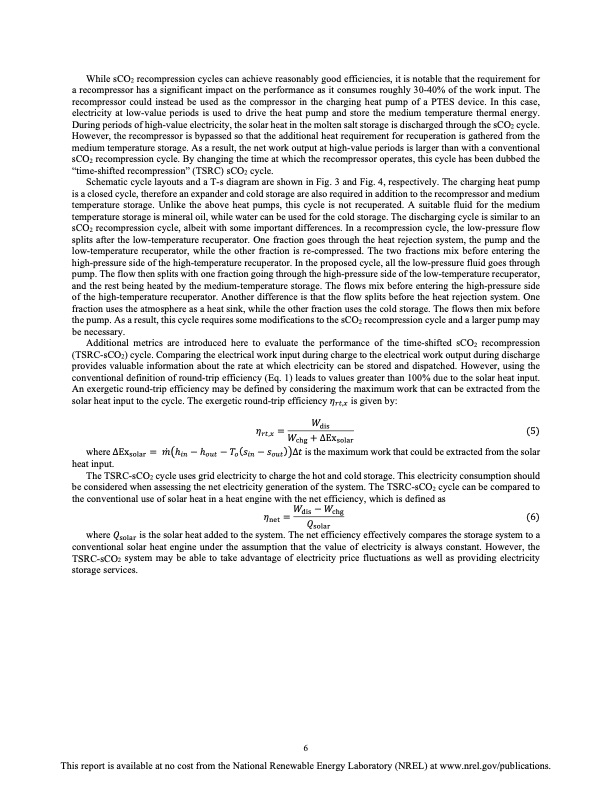
PDF Publication Title:
Text from PDF Page: 009
While sCO2 recompression cycles can achieve reasonably good efficiencies, it is notable that the requirement for a recompressor has a significant impact on the performance as it consumes roughly 30-40% of the work input. The recompressor could instead be used as the compressor in the charging heat pump of a PTES device. In this case, electricity at low-value periods is used to drive the heat pump and store the medium temperature thermal energy. During periods of high-value electricity, the solar heat in the molten salt storage is discharged through the sCO2 cycle. However, the recompressor is bypassed so that the additional heat requirement for recuperation is gathered from the medium temperature storage. As a result, the net work output at high-value periods is larger than with a conventional sCO2 recompression cycle. By changing the time at which the recompressor operates, this cycle has been dubbed the “time-shifted recompression” (TSRC) sCO2 cycle. Schematic cycle layouts and a T-s diagram are shown in Fig. 3 and Fig. 4, respectively. The charging heat pump is a closed cycle, therefore an expander and cold storage are also required in addition to the recompressor and medium temperature storage. Unlike the above heat pumps, this cycle is not recuperated. A suitable fluid for the medium temperature storage is mineral oil, while water can be used for the cold storage. The discharging cycle is similar to an sCO2 recompression cycle, albeit with some important differences. In a recompression cycle, the low-pressure flow splits after the low-temperature recuperator. One fraction goes through the heat rejection system, the pump and the low-temperature recuperator, while the other fraction is re-compressed. The two fractions mix before entering the high-pressure side of the high-temperature recuperator. In the proposed cycle, all the low-pressure fluid goes through pump. The flow then splits with one fraction going through the high-pressure side of the low-temperature recuperator, and the rest being heated by the medium-temperature storage. The flows mix before entering the high-pressure side of the high-temperature recuperator. Another difference is that the flow splits before the heat rejection system. One fraction uses the atmosphere as a heat sink, while the other fraction uses the cold storage. The flows then mix before the pump. As a result, this cycle requires some modifications to the sCO2 recompression cycle and a larger pump may be necessary. Additional metrics are introduced here to evaluate the performance of the time-shifted sCO2 recompression (TSRC-sCO2) cycle. Comparing the electrical work input during charge to the electrical work output during discharge provides valuable information about the rate at which electricity can be stored and dispatched. However, using the conventional definition of round-trip efficiency (Eq. 1) leads to values greater than 100% due to the solar heat input. An exergetic round-trip efficiency may be defined by considering the maximum work that can be extracted from the solar heat input to the cycle. The exergetic round-trip efficie𝑊𝑊ncy 𝜂𝜂 is given by: heat input. The TSRC-sCO2 cycle uses grid electricity to charge the hot and cold storage. This electricity consumption should net 𝜂𝜂= dis𝑟𝑟𝑟𝑟,𝑥𝑥 (5) 𝑊𝑊chg + ΔExsolar where ΔExsolar = 𝑚𝑚̇ �h𝑖𝑖𝑖𝑖 − h𝑜𝑜𝑜𝑜𝑟𝑟 − 𝑇𝑇𝑜𝑜(𝑠𝑠𝑖𝑖𝑖𝑖 − 𝑠𝑠𝑜𝑜𝑜𝑜𝑟𝑟)�Δ𝑡𝑡 is the maximum work that could be extracted from the solar 𝑟𝑟𝑟𝑟,𝑥𝑥 be considered when assessing the net electricity generation of the system. The TSRC-sCO2 cycle can be compared to the conventional use of solar heat in a heat engine with the net efficiency, which is defined as 𝜂𝜂 dis solar chg = 𝑊𝑊 𝑄𝑄− 𝑊𝑊 (6) where 𝑄𝑄solar is the solar heat added to the system. The net efficiency effectively compares the storage system to a conventional solar heat engine under the assumption that the value of electricity is always constant. However, the TSRC-sCO2 system may be able to take advantage of electricity price fluctuations as well as providing electricity storage services. 6 This report is available at no cost from the National Renewable Energy Laboratory (NREL) at www.nrel.gov/publications.PDF Image | Supercritical CO2 Heat Pumps Concentrating Solar Power

PDF Search Title:
Supercritical CO2 Heat Pumps Concentrating Solar PowerOriginal File Name Searched:
77955.pdfDIY PDF Search: Google It | Yahoo | Bing
CO2 Organic Rankine Cycle Experimenter Platform The supercritical CO2 phase change system is both a heat pump and organic rankine cycle which can be used for those purposes and as a supercritical extractor for advanced subcritical and supercritical extraction technology. Uses include producing nanoparticles, precious metal CO2 extraction, lithium battery recycling, and other applications... More Info
Heat Pumps CO2 ORC Heat Pump System Platform More Info
| CONTACT TEL: 608-238-6001 Email: greg@infinityturbine.com | RSS | AMP |